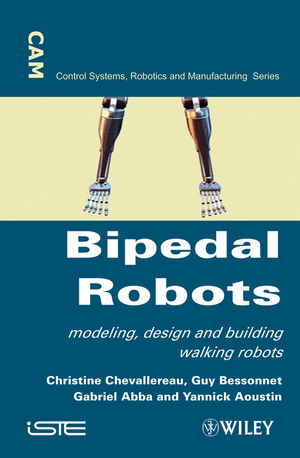Bipedal Robots: Modeling, Design and Walking SynthesisISBN: 978-1-84821-076-9
Hardcover
338 pages
January 2009, Wiley-ISTE
 This is a Print-on-Demand title. It will be printed specifically to fill your order. Please allow an additional 10-15 days delivery time. The book is not returnable.
|
||||||
Chapter 1. Bipedal Robots and Walking
1.1. Introduction 1
1.2. Biomechanical approach 2
1.2.1. Biomechanical system: a source of inspiration 2
1.2.2. Skeletal structure and musculature 9
1.3. Human walking 11
1.3.1. Architecture 11
1.3.2. Walking and running trajectory data. 13
1.3.3. Study cases 18
1.4. Bipedal walking robots: state of the art 21
1.4.1. A brief history 21
1.4.2. Japanese studies and creations 24
1.4.3. The situation in France 27
1.4.4. General evolution tendencies 31
1.5. Different applications 32
1.5.1. Service robotics 33
1.5.2. Robotics and dangerous terrains 35
1.5.3. Toy robots and computer animation in cinema 35
1.5.4. Defense robotics 37
1.5.5. Medical prostheses 39
1.5.6. Surveillance robots 40
1.6. Conclusion 40
1.7. Bibliography 41
Chapter 2. Kinematic and Dynamic Models for Walking
2.1. Introduction 47
2.2. The kinematics of walking 48
2.2.1. DoF of the locomotion system 48
2.2.2. Walking patterns 49
2.2.3. Generalized coordinates for a sagittal step 53
2.2.4. Generalized coordinates for three-dimensional walking 57
2.2.5. Transition conditions 66
2.3. The dynamics of walking 70
2.3.1. Lagrangian dynamic model 71
2.3.2. Newton-Euler’s dynamic model 87
2.3.3. Impact model 98
2.4. Dynamic constraints. 103
2.4.1. CoP and equilibrium constraints 103
2.4.2. Non-sliding constraints 116
2.5. Complementary feasibility constraints 117
2.5.1. Respecting the technological limitations 118
2.5.2. Non-collision constraints 119
2.6. Conclusion 123
2.7. Bibliography 123
Chapter 3. Design Tools for Making Bipedal Robots
3.1. Introduction 127
3.2. Study of influence of robot body masses 128
3.2.1. Case 1: the three-link robot 129
3.2.2. Case 2: the five-link robot 147
3.3. Mechanical design: the architectures carried out 165
3.3.1. The structure of planar robots 165
3.3.2. 3D robot structures 168
3.3.3. Technology of inter-body joints 172
3.3.4. Drive technology 174
3.4. Actuators 181
3.4.1. Actuator types 181
3.4.2. Characteristics of electric actuators 186
3.4.3. Elements of choice for robotic actuators 190
3.4.4. Comparing actuator performances 193
3.4.5. Performances of transmission-actuator associations 202
3.5. Sensors 207
3.5.1. Measuring 207
3.5.2. Frequently used sensors 208
3.5.3. Characteristics and integration 209
3.5.4. Sensors of inertial localization 210
3.6. Conclusion 212
3.7. Appendix 213
3.7.1. Geometric model 213
3.7.2. Dynamic model 213
3.8. Bibliography 215
Chapter 4. Walking Pattern Generators
4.1. Introduction 219
4.2. Passive and quasi-passive dynamic walking 220
4.2.1. Passive walking 220
4.2.2. Quasi-passive dynamic walking 222
4.3. Static balance walking 227
4.4. Dynamic synthesis of walking 228
4.4.1. Performance criteria for walking synthesis 228
4.4.2. Formalizing the problem of dynamic optimization 232
4.5. Walking synthesis via parametric optimization 236
4.5.1. Approximating the control variables 237
4.5.2. Parameterizing the configuration variables 238
4.5.3. Parameterizing the Lagrange multipliers 246
4.5.4. Formulation of the parametric optimization problem 250
4.5.5. A parametric optimization example 255
4.6. Conclusion 261
4.7. Bibliography 262
Chapter 5. Control
5.1. Introduction 267
5.2. Hybrid systems and stability study 269
5.3. Taking into account the unilateralism of the contact constraint 273
5.3.1. Computed torque control 273
5.4. Online modification of references 282
5.4.1. General principle 282
5.4.2. The ZMP’s imposed evolution 285
5.4.3. Bounded evolution of the ZMP 292
5.5. Taking an under-actuated phase into account 296
5.6. Taking the double support phase into account 301
5.7. Intuitive and neural network methods 306
5.7.1. Intuitive methods 306
5.7.2. Neural network method 311
5.8. Passive movements 318
5.9. Conclusion 322
5.10. Bibliography 323
Index 327



